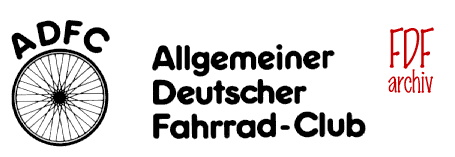
Bicycle Research Service: ForschungsDienst Fahrrad
FDF 218 - 28.05.1994
VOLKER BRIESE:
HISTORY OF CYCLE TRACKS
Cycle tracks for the expansion of motorised traffic
Key points: At the start of the twentieth century the first cycle tracks were constructed for the comfort of cyclists. Since the end of the 1920s, cycle tracks have been required and promoted as a prerequisite for the expansion of motorised traffic. It was only in the 1930s that cyclists were forced to use cycle tracks, allegedly for their own safety.
Main content: Volker Briese has reviewed the industry newspaper "Radmarkt" (Bicycle Market), that has been published since 1886, and has compiled the history of cycle tracks in Germany up until 1940. In the nineteenth century people began to demand cycle tracks because the unpaved roads and roadways paved with large stones were clearly unsuitable for cycling.
The first special tracks that were constructed for cyclists did not follow standardised guidelines or state specifications.
In Bremen, Hamburg and Luneburg these tracks were initially sections of the roadway that had been improved for cyclists. In the environs of Hanover and Magdeburg the tracks were for the purpose of recreational cycling and for making excursions. These were constructed thanks to the self -help initiatives of cycling clubs or as municipally provided facilities.
Between 1926 and 1928 firm demands were made to remove cyclists from the roadways through the construction of cycle tracks. The first bible of cycle track construction, "The economic significance of cycle traffic and the construction of cycle tracks," was published by Dr. Henneking in 1926. This brought about the development of the "Guidelines for creation of cycle tracks" by the Study Group for the Construction of Roads for Automobiles in 1927. In contrast to the example of England, from this time the construction of cycle tracks intensified in Germany, so that cyclists finally come "off the streets"
In the National Socialist era cycle-track construction became integrated into state and party propaganda as an important pre-requisite for the furtherance of motorised traffic. The construction of cycle tracks was supported by the National Socialist Motorist Corps (NSKK) and the German Automobile Club (DDAC).
In the "Road Traffic Regulation of the Reich" (RStVO) introduced on October 1, 1934, the rights of cyclists, equestrians and pedestrians to use streets were considerably restricted. "Where a road is assigned to a particular type of traffic (Footpaths, Cycle Track, Bridle paths), then this traffic is restricted to that part of the road assigned to it."
Compulsory cycle track use was the main disciplinary instrument faced by cyclists, although in the 1930s, with a ratio of 20:3, they still had a clear majority over motorised traffic. We can conclude from the intense propaganda surrounding the compulsory use of cycle-tracks from 1934 onwards that the cyclists were not happy with the new narrow, inexpensive and poorly surfaced cycle tracks and preferred to use the main roadways instead. While the Reich's Autobahns were being celebrated as "Adolf Hitler's roads" the cycle tracks were being termed "the roads of the little man". "Let us show the marvelling foreigners (during the forthcoming Olympic Games 1936) proof of an up-and-coming Germany; a Germany where the motorist has bicycle-free and safe access not only to the autobahns but to all roads".
V. Briese: "Cycle track construction before the second world war - back to the future"", in: Radmarkt 5/1993. "Cycle tracks, Opium for the cyclist", in Radfahren 1/1994. "Cycle tracks. Automobile associations determine bicycle policy", in: Radfahren 2/1994.
Address: Prof. Dr. Volker Briese, Elser Kirchstr. 39, 33106 Paderborn; Tel. 0521-69450.
http://www-2.informatik.umu.se/adfc/fdf/fdf-218.html
(Translated by Shane Foran Jan 2004 with some help from friends in Germany)
Until 1999, the ADFC's Bicycle Research Service published reports on traffic issues and cycle politics on a fortnightly basis Many thanks to Tilman Bracher, Mattias Doffing and to Elmar Steinbach, who have published these reports on the Internet
The Bicycle Research Service was discontinued mid-1999 It was superseded by the Bicycle Research Reports which can be subscribed from the ECF (www.ecf.com) European Cyclists' Federation ECF - Rue de Londres 15 (b 3) - B-1050 Brussels - Phone: +32-2-512 98 27 - Fax: +32-2-511 52 24, e-mail: mailto:office@ecf.com
